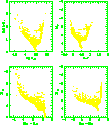Perhaps the most extended library of isochrones in literature is by
Bertelli et al. (1994). The great merit of this library is that it satisfies the
basic criteria of adequacy and accuracy of the input physics in the
stellar model calculations, and homogeneity.
The isochrones span the age range from a few 10![]() yr
to beyond 18 Gyr, and cover all evolutionary phases from the zero
age main
sequence up to either the stage of PN formation and cooling toward the
White Dwarf regime or central C-ignition
depending upon the mass of the most evolved star in the isochrone.
The chemical compositions are in the range
[Z=0.0001, Y=0.23] to [Z=0.1, Y=0.475] and obey the enrichment law
yr
to beyond 18 Gyr, and cover all evolutionary phases from the zero
age main
sequence up to either the stage of PN formation and cooling toward the
White Dwarf regime or central C-ignition
depending upon the mass of the most evolved star in the isochrone.
The chemical compositions are in the range
[Z=0.0001, Y=0.23] to [Z=0.1, Y=0.475] and obey the enrichment law
![]() . For the purposes of this study, the Bertelli
et al. (1994) isochromes have been revised in relation to the algorithm adopted to
describe mass loss by stellar wind during the AGB phase. In this paper,
following Marigo et al. (1996) we make use of a semi-empirical formalism
which relates the mass loss rate
. For the purposes of this study, the Bertelli
et al. (1994) isochromes have been revised in relation to the algorithm adopted to
describe mass loss by stellar wind during the AGB phase. In this paper,
following Marigo et al. (1996) we make use of a semi-empirical formalism
which relates the mass loss rate ![]() to the pulsational period P of
Mira variables and pulsating OH/IR stars both in the Galaxy and in the LMC
(Vassiliadis & Wood 1993). The advantage of this prescription is the onset
of the superwind phase which develops naturally on the AGB, instead of the
ad hoc
sudden increase that is needed with classical Reimers-like laws, cf.
Reimers (1975) and Renzini & Voli (1981).
No other details of the isochrone construction are given here for the
sake of brevity.
to the pulsational period P of
Mira variables and pulsating OH/IR stars both in the Galaxy and in the LMC
(Vassiliadis & Wood 1993). The advantage of this prescription is the onset
of the superwind phase which develops naturally on the AGB, instead of the
ad hoc
sudden increase that is needed with classical Reimers-like laws, cf.
Reimers (1975) and Renzini & Voli (1981).
No other details of the isochrone construction are given here for the
sake of brevity.
Figures 11 (click here)-13 (click here) show a few selected CMDs for the WFPC2 pass-bands whereas Fig. 14 (click here) is the same but for the FOC. Each CMD contains three isochrones with age 10 Gyr, 1 Gyr and 0.01 Gyr and composition [Y=0.28, Z=0.020].
All the CMDs are constructed using the conventional format so that the left side has a smaller colour value.
But for the cases with the extreme UV pass-bands such as 15F, 17F, 22F, 43F, 17W, 21W, 30W, and 33W, the CMDs look normal and (as expected) much like to those in the classical Johnson system. In contrast, in the case of the far UV pass-bands the above mentioned colour turnover occurs, giving rise to unfamiliar sequences in CMDs. This implies that care must be paid when UV data for stars and star clusters are to be interpreted and associated to a certain evolutionary phase. See for instance the CMD of 47Tuc studied by Paresce et al. (1991).
It is worth noticing that, depending on the particular colour in usage, if the CMD looks normal at old ages it may reverse itself at young ages and viceversa. Furthermore there are CMDs in which particular evolutionary stages are enhanced with respect to others. For instance in the CMD for the pass-bands 30W and 85W, the turn-off is always brighter than or as bright as the remaining evolutionary stages. Magnitudes and colours in these pass-bands are potentially good age indicators.
There are CMDs in which young isochrones are fully degenerate in the sense that all evolutionary stages beyond the main sequence are first pushed to much fainter magnitudes and second to colours that are indistinguishable from the main sequence phase.

Figure 17: Synthetic CMDs for an assembly of stars whose star formation history
is meant to resemble the one that took place in the nearby galaxy NGC 205.
The various panels show the same CMD but in
different planes. Notice how the RGB and HB stars visible in the BV-CMD are
folded onto the main sequence in ![]() versus
versus ![]() plane. See
the text for more details
plane. See
the text for more details